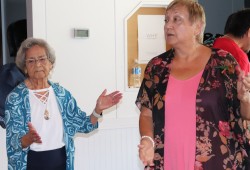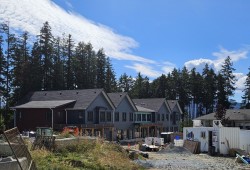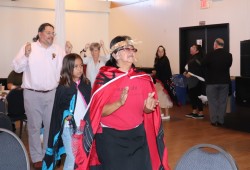The near-completion of the construction of Oomiiqsu (Mother) Centre, developed by Huu-ay-aht First Nation, was celebrated by dozens of supporters at Port Alberni’s Italian Hall on September 5th. The one-of-a-kind centre, which opens later this year, will provide supportive housing and services to Aboriginal women and children in Port Alberni.
According to Huu-ay-aht leaders, plans for the centre began in earnest when their treaty was implemented in 2011, giving them the resources needed to move forward. “We needed to address a fundamental challenge – there was probably over 40 percent of children in care and that is not including those at risk of intervention,” said Huu-ay-aht elected chief John Jack.
“The work started probably in the 70s and 80s,” said Jack, “when people said something needs to change.” Too many Indigenous children were in the foster care system following the closure of residential schools in the region.
“We need to help parents and families break the cycle,” said Jack. And, with the help of the Social Services Panel, recommendations were made, and partnerships were formed.
Huu-ay-aht First Nation leadership broke ground for the new building in 2022. The Oomiiqsu Centre will provide services and support to Aboriginal mothers and children with the goal of keeping families together. But first, Huu-ay-aht leadership approached Tseshaht and Hupacasath First Nations, in whose territory Oomiiqsu Centre would be built, seeking their approval and support for the centre – an important aspect of cultural protocol.
“When we were approached by Huu-ay-aht we were in full support,” said Hupacasath Chief Brandi Lauder. “We need many options to become a stronger community than we were in the 70s.”
The new centre is not only for Huu-ay-aht families but also for other Indigenous families in the Alberni Valley. “This new centre will help women gain their strength and confidence…thank you, Huu-ay-aht,” said Lauder.
Tseshaht Elected Chief Wameesh, Ken Watts, spoke of important cultural teachings and how the word, uu-a-thluk means ‘to take care of’. Speaking to the Huu-ay-aht leaders, he said, “you’re a true champion for taking care of your people.”
MP Gord Johns congratulated the Huu-ay-aht and their partners, reminding them that champions don’t do things on their own. He commended HFN Councillor Ed Johnson, who took the lead on Oomiiqsu Centre as part of his council portfolio. Together, with Nuu-chah-nulth nations, the City of Port Alberni and NDP government partnerships, the new concept came to life, Johns noted.
“Oomiiqsu is going to be a place to bring children home, where mothers and children will feel safe, healthy and connected, and they will be able to look back and tell many wonderful stories,” Huu-ay-aht Council Member Edward R. Johnson said in a Nov. 2022 statement.
The new development includes transition housing, a childcare and support centre that will be managed and operated by the Huu-ay-aht government’s Child and Family Wellness Department. The centre will be operated by Huu-ay-aht government, providing supportive services 24 hours a day, seven days a week, to Indigenous mothers facing challenges.
There will be space for up to 48 mothers and children escaping abuse, facing mental health challenges, addictions, poverty, or other barriers to wellness. The childcare centre will have eight spaces for children up to three years old and 16 spaces for children 30 months to school age.
Huu-ay-aht partnered with the government of British Columbia to develop Oomiiqsu Centre. The province has invested about $10 million through the Building BC: Women’s Transition Housing Fund with an additional $88,000 in annual operating funding. The Ministry of Education and Child Care is contributing $800,000 for childcare spaces.
“At Oomiiqsu, they (mothers and children in need) will find stability, security and access to support in a way that works specifically for the Nuu-chah-nulth people,” said Murray Rankin, Minister Responsible for Housing, in a 2022 statement.
“It is important to do what we can to keep families together. It is important that we work for our children to be healthy, safe, and connected to their community and to their culture,” said Jack.
“Hopefully, this will be replicated across Canada, this is history,” said Johns, adding that this centre will save lives and could be the beginning of the end of the child welfare system. “This is what reconciliation looks like,” said Johns.
Oomiiqsu Centre is expected to be up and running by the end of 2024.




